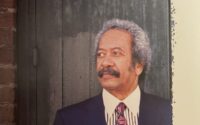The Lineage Sound
I grew up moving around. Following my dad’s TV news career, we’d pick up and shift to a new city if not every year then every two years. I can’t say for sure, but I suspect all of that shuffling does something to a person, framing life in terms of windshields and rearview mirrors. When you’re always arriving or leaving, your sense of connection can feel a bit…frayed.
What connection I’ve found over the years has arisen most abundantly through music. When I lived in New Orleans, I heard tell about the Acadians and how they settled in Louisiana as Cajuns. I knew there existed some bridge to that ancestry on my paternal grandmother’s side—my French-Canadian nana—and something in the thick, piquant sound of a Cajun fiddle roused my blood. Given that the Germans have a notorious gift for words carved out of specific experiences, they must have something for the feeling that comes over you when you hear a new sound that channels an archive residing deep in your marrow, how unearthing that kind of music is both mirror and map.
Beausoleil might be one of the most well-known Cajun bands running, and I picked up a copy of their 1986 album Bayou Boogie shortly into my Louisiana tenure. I adored the two-steps peppering the album, but it was the enchanting instrumental waltz “Chez Seychelles” that quickly became my favorite. I’d never heard it before I played Bayou, and when it started I thought it sounded like a sunburst over the sea, like the water reaching for the light and glimmering in return.
This week I’m visiting Halifax, where I’ve been learning more about the Acadians who once resided in the seventeenth-century French colony known as Acadie if you’re French (or Acadia if you’re not). When the English gained control of the region, they viewed the Acadians as a military threat and in 1755 deported them to many places, including Louisiana. The upheaval became known as the Acadian Expulsion.
In the midst of that turmoil so much could have been lost, including the group’s musical traditions. Instead, they kept playing, but let the swampy heat of their new surroundings bend the “Down East” sound that once defined Acadian fiddle into something warmer and more playful. How lucky to hear it in the years I lived in Louisiana—and how lucky to venture northeast to Halifax and see where it all started.
To stand along the Harbour’s edge looking across to Georges Island, where many of the Acadians were kept before being deported, felt like reaching the beginning after first having heard the end. After years in Louisiana teeming with Cajun fiddles, I’d made it back to the origin point. I wish I could say that I came across a traditional Acadian band while I’ve been here, but alas no. I did hear a traditional Celtic three-piece that satisfied the itch, and considering that Celtic/American fiddle-playing influenced the Acadian sound, it felt like a strong second best.
Given that most of my life has been following the lines of a new making, it was enough to trace something older and inherited, to see myself in a larger part of history and stand at the shore thinking of all that had to pass in between so I could arrive and listen.




